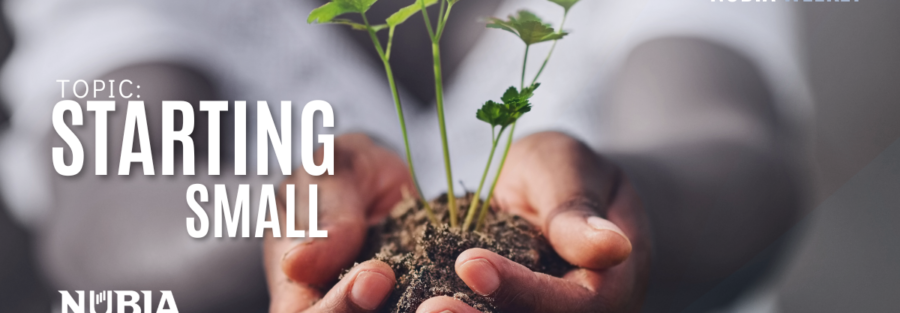For many founders, there is some unsolicited advice you should have seen across social media platforms by thought leaders and venture builders. One of those popular ones would be to start small.
We are pleased to share that this is a piece of solid advice. We know it but you might not. This is because you’re super excited about the big market, the figures from your TAM/SAM/SOM, the vision of this business and how you will conquer the world.
In this episode of Nubia Weekly, we will dissect what starting small means, why you should start small, how to know you’re not going after a giant market, signs that you’re making a mistake and how to find your way back to starting small.
Starting small in this context for startup founders means targeting only a tiny part of your target market. It means focusing on one user type in one industry and in one market. See how small that is? Starting small means selling or rendering services to one customer niche in one market segment.
What is a market segment? Segmentation helps marketers make the right offers to the right customers with the right message. Semrush describes it as a group of individuals within a larger target market who share a particular set of characteristics. A typical example will be this: If you are looking at becoming Nike – an athletic footwear brand, start with making athletic footwear for just the athletes. The alternative would be taking into consideration other market segments like the grandma who wants shoes to take a walk, the millennial who needs gym/running shoes and the student who needs a comfortable shoe to walk a long distance to and from school.
Why should you start small?
It is the best way to fail. You will most likely fail in building your startup one way or another. Failure here means you tried something and it didn’t work. The best way to fail will be to fail forward. It means using that failure as a stepping stone to success not just because we want to but because of the structure we put in place. This structure is called the structure of testing. Chunkai Mui puts it this way: Successful innovators “start small” after thinking big. Rather than jumping on the bandwagon for one potentially big product, they break the idea down into smaller pieces for testing. They don’t allow themselves to make decisions solely on intuition or allow themselves to lock in on financial projections based on wishful thinking. They defer important decisions until they have real data. Product testing is done by gathering feedback directly from customers or potential customers about a product. The feedback can be through informal conversation, formal surveys, or even indirectly through data about clicks on an online advertisement or traffic to a website.
Look at all the mega companies we have today.
Amazon started as an online bookstore selling books, primarily competing with local booksellers and Barnes & Noble. The book industry was so small that it was unimaginable how they could become a world-class leading organisation with that. Through their innovative idea of an online marketplace for books, they tested e-commerce and soon added more items to its product category. The diversification led it to be named “the Everything Store”. Books weren’t even the bone of contention from the beginning. It was just a small enough market to start from. But imagine if they started as the everything store, they wouldn’t have tested the market enough to understand the strengths, techniques and risks in retaining that name.
Start small to gain dominance in that market and easily outshine your competitors. Imagine starting with a niche market with little competitors, maybe even zero. Everyone in that niche market knows and sees you as the best. You start small yet solve major problems for these people. You gain prominence and strength and then expand and add three more segments. With a great understanding of your customers comes great marketing, a step closer to being “an everything store”.
How do you know you are pursuing a giant market at an early stage even when you think you aren’t?
Who needs what and why?
- The who. The who is not specific enough and you cannot describe your customers in one sentence i.e students from Nigeria who live in America
- The what. What exactly do they need? Again, you cannot say this in a short breath
- The why. What is the reason they need you?
If you are at an early stage or you started with a giant market, this is your cue to go back and start with something small. Chances are you are preventing a giant failure coming in the future. To find your way back, go through the design thinking method and create a problem statement – Who needs what and why, then begin from there.
Conclusion
The advice to “start small” for early-stage founders is solid and often overlooked in the excitement of pursuing big markets and visions. Starting small means focusing on a tiny portion of the target market, such as one user type in one industry and market segment. This approach allows for failure in a manageable way and enables learning through structured testing. Many successful companies, like Amazon, began by addressing a small market before expanding. Starting small helps gain dominance in a niche market, allowing for gradual expansion while maintaining a strong customer base. Early-stage founders should reassess if they’re pursuing too large a market and consider starting small to prevent potential failure. Utilizing design thinking methods, such as creating a problem statement, can help guide this process.




